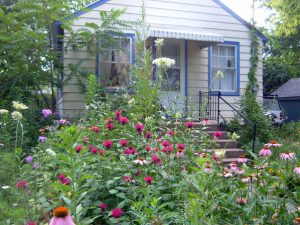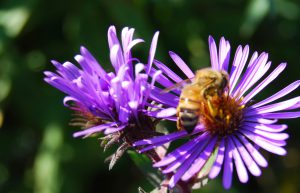“EAB! EAB! EAB!” We chanted while frantically attempting to catch a shiny green beetle perched on a street ash tree. It was a sight to see – three of us excitedly jumping around an ash tree, measuring its diameter with tape, and looking for signs of damage from a beetle that is no bigger than a penny. It was the first day out in the field, assessing ash trees in the City of Poughkeepsie.
The emerald ash borer (EAB) is an invasive, wood-boring beetle that has the capacity to decimate entire populations of ash trees. Urban tree populations are especially at risk because of high traffic, by which infested firewood and nursery trees can be transported. The City of Poughkeepsie has a substantial population of ash trees that are vulnerable to EAB infestation – symptoms of EAB infestation were observed on ash trees in the outskirts of the City and sporadically throughout City streets.
Over the summer, the Environmental Cooperative at Vassar Barns worked to complete an assessment of EAB infestation for the City of Poughkeepsie. Two Vassar students, Elise Chessman and India Futterman, worked with data from a 2006 street tree inventory, plotting tree points in ArcGIS using address geocoding as part of a Natural Resource Inventory Grant that the Cooperative received in order to propose management options for the mitigation of ash tree loss due to EAB. They ground-truthed and corrected these tree locations in the field using the ArcGIS Collector app.
Tree condition was assessed based on the presence of stress symptoms. Distinct signs of beetle activity, such as d-shaped exit holes and s-shaped galleries, were noted as indicators of EAB. Of 405 street ash trees, 34 (8.4%) demonstrated definitive signs of EAB infestation, while 283 (58.8%) appeared symptomatic for infestation. These results indicate that EAB is established among the City’s street ash trees and the beetle will likely spread to infest all or most of the City’s ash. The Environmental Cooperative plans to utilize this information in the creation of an EAB management plan, including a published version of the tree point map. This document will aid in the City’s future urban forestry maintenance.
Since the first day out in the field, our methods of assessment greatly improved. What we first thought was an EAB sighting turned out to be an insect commonly mistaken for the emerald beetle – though the meticulous Vassar interns eventually found the real culprit on one of the City’s ash trees! While management plans for street trees in the City are in discussion, there are a few steps to take if you have ash trees in your yard:
Identify for certain if your tree is an ash, then look for signs of EAB
D-shaped holes, S-shaped galleries under the bark (where the larvae live), vertical bark splitting, unusual branching at the bottom of the tree, and woodpecker activity are strong indications that your tree is infested with EAB. The larvae cut off the flow of nutrients to the canopy under the bark, causing the tree to die.
Figure out if your tree is worth saving
Many trees are too small to be be worth attempting to spray. Measure the width of your tree in order to determine if you should replace it or save it. If the trees diameter is above 15 inches, treatment is an option, but the injection is costly and must be reapplied every three years. Otherwise, the tree will eventually need to come down. The wood can be used as firewood and can be chipped, but don’t move it! Moving firewood causes EAB to travel and infect more trees.
Consider replacing your tree with something native to the Hudson Valley
Here are some potential tree species to consider if you want to replace your ash tree:
-Mountain Ash
-Hackberry
-Basswood (great pollinator habitat!)
-Hybrid elm
-Dogwood


